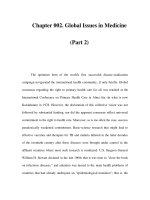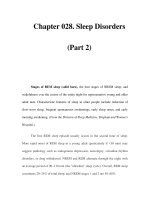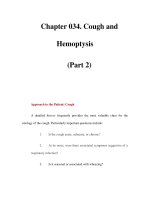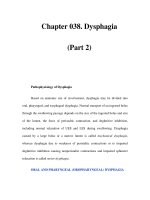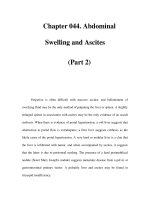Neurological Differential Diagnosis - part 2 pps
Bạn đang xem bản rút gọn của tài liệu. Xem và tải ngay bản đầy đủ của tài liệu tại đây (858.78 KB, 56 trang )
42 Chapter 1
Pigmented lesions in the CNS
1 Metastatic malignant melanoma
◆
Most common pigmented lesion in the CNS.
2 Melanocytoma
◆
The proliferating cells are melanocytes with the predilection for the leptome-
ninges.
◆
Most of the lesions are benign, pigmented, meningeal-based tumors, so called
meningeal melanocytoma.
◆
Half of lesions are located intracranially, especially in the posterior fossa. The
rest occur in the spinal canal as intradural extramedullary masses in the cervi-
cal and thoracic regions.
◆
While most meningeal melanocytomas occur without cutaneous stigmata,
some patients have pigmented skin lesions, raising the possibility of metastatic
malignant melanoma or a neurocutaneous syndrome.
3 Melanocytic schwannoma
◆
Distinctive psammomatous melanocytic schwannoma is easily recognized and
can be associated with Carney complex (myxomas, spotty pigmentation, en-
docrine overactivity, and multiple psammomatous melanotic schwannoma).
4 Meningeal melanocytosis
◆
Refers to a set of lesions characterized by a diffuse proliferation of melanocytic
cells within leptomeninges without a dominant mass lesion.
◆
Presentation is usually in childhood and can manifest with increased intracra-
nial pressure with hydrocephalus. Neuroimaging often reveals diffuse menin-
geal enhancement. CSF cytology is usually positive.
◆
The main differential diagnosis in this rare disorder is superfi cial siderosis due
to chronic leakage of blood into the CSF, which may accompany meningeal
melanocytomas.
◆
Although the proliferating cells may appear cytologically benign, meningeal
melanocytosis is a lethal disorder, with death often occurring within a year of
diagnosis.
•
Among all the pigmented lesions in the CNS, metastatic malignant
melanoma is the most common.
•
Other differential diagnoses in this group represent rare entities. However,
distinguishing these lesions from malignant melanoma is critically
important, since some of the lesions are benign and therefore the treatment
is vastly different.
Neuroanatomy and Neuropathology 43
Positive CSF cytology without a history of malignancy
Type of malignancy Percentage of cases fi rst
diagnosed by positive CSF
cytology
Unknown primary 70
Gastric adenocarcinoma 67
Bronchogenic carcinoma 18
Malignant melanoma 8
Primary CNS tumor (e.g. medulloblastoma, glioblastoma, etc.) 5
Malignant lymphoma 2
Ref: Bigner S.H., Johnston W.W. The diagnostic challenge of tumors manifested initially by the shedding of
cells into cerebrospinal fl uid. Acta Cytol 1984; 28: 29–36.
Rosenthal fi bers
Rosenthal fi bers are observed in:
1 Reactive states
◆
Most often those associated with signifi cant chronicity, such as syringomye-
lia and around the margins of nonglial, slow-growing tumors, such as cranio-
pharyngioma and hemangioblastoma.
•
CSF samples that show malignant cells in the absence of any history of
malignancy represent a special dilemma.
•
This accounts for approximately 11% of patients with positive CSF
malignant cytology. Most occult carcinomas with leptomeningeal
manifestations are in the lung or the stomach. However, the primary sites are
unknown in the majority of cases. Breast carcinoma commonly involves the
leptomeninges, but is usually clinically apparent prior to meningeal spread.
•
The diagnosis and classifi cation of malignancy that presents initially in the
CSF should proceed in a stepwise fashion. The fi rst distinction is whether
the cells are hematopoietic or nonhematopoietic. Then, the carcinomas can
be further divided into adenocarcinoma, squamous cell carcinoma, small
cell carcinoma, or undifferentiated carcinoma. In the next step, clinical and
radiographic investigation will provide further clues to the diagnosis. As a
general rule, most small cell carcinoma originates from the lung, whereas
most squamous cell carcinoma comes from the head and neck.
•
Rosenthal fi bers are opaque, homogeneous, brightly eosinophilic
intracytoplasmic structures, which exhibit elongated, anfractuous
(corkscrew or lumpy-bumpy) profi les.
44 Chapter 1
2 Metabolic/genetic disorders
◆
Rosenthal fi bers are morphological hallmarks of Alexander disease (of which
some forms are now known to arise from mutations of the gene encoding glial
fi brillary acidic protein, GFAP).
3 Neoplasia
◆
Most characteristic of pilocytic astrocytoma.
◆
It can also be found in a wide variety of gliomas.
The importance of recognizing Rosenthal fi bers in an astrocytic neoplasm cannot
be overemphasized. The nuclear polymorphism of most pilocytic astrocytomas
is more than suffi cient to suggest anaplastic astrocytoma; the identifi cation of
Rosenthal fi bers signifi cantly mitigates the risk of this potential overdiagnosis.
4 Others
◆
Axonal neuropathy
Rosenthal fi bers
Senile plaques
1 Elderly individuals
◆
Plaques occur in the cortex with increased frequency in aging. In normal aging,
the plaques are mainly diffuse.
◆
There may be small numbers of neuritic plaques, most associated with ubi-
quitin- and chromogranin-immunoreactive neuritis that do not contain tau
protein.
•
Plaques are extracellular 20–150 μm structures consisting of a central pink
amyloid core surrounded by blunt swollen neuritic processes.
•
The amyloid is composed of Aβ peptide, derived by proteolytic breakdown
from a normal neuronal membrane protein called amyloid precursor
protein (APP). Like tangles, they stain well with silver stains.
•
There are four main types of plaques; diffuse, primitive, classic, and burnt-
out. It is believed that there is progression from diffuse through fi nally
burnt-out plaques. However, there is no defi nitive evidence for this.
Neuroanatomy and Neuropathology 45
2 Alzheimer disease (AD)
◆
Plaques are widely distributed in the brain of patients with AD. The neocortex
and hippocampus are always involved. Most neuritic plaques include tau-im-
munoreactive dystrophic neurites.
3 Amyloid angiopathy
4 Down syndrome
Senile plaques
Synucleinopathies
1 Lewy body disorders
◆
Lewy bodies are intracytoplasmic inclusions composed of several proteins,
including ubiquitin and α-synuclein. α-synuclein immunohistochemistry is
now widely used to recognize this pathological marker in both brainstem and
cortical lesions.
•
The synucleinopathies are a subset of neurodegenerative disorders that
have in common a pathological lesion composed of fi brillary aggregates of
insoluble α-synuclein protein in selective populations of neurons and glia.
•
Synuclein belongs to a family of brain proteins. It consists of three
members: α-, β-, and γ-synuclein. The α-synuclein gene is located on
chromosome 4, and only α-synuclein is associated with the fi lamentous
inclusions. In diseases where it aggregates, α-synuclein changes
conformation and aggregates with fi brils of β-sheet structure similar to
other amyloid proteins.
•
Abnormal fi lamentous aggregates of misfolded α-synuclein protein are
the major components of Lewy bodies, dystrophic (Lewy) neuritis, and the
Papp-Lantos fi laments in oligodendroglial and neurons in multiple system
atrophy linked to degeneration of affected brain regions.
46 Chapter 1
◆
The presence and distribution of Lewy bodies has led to a clinicopathological
classifi cation of Lewy body disorder spectrum.
1.1 Parkinson disease (PD): brainstem type of Lewy bodies
■
Sporadic form: most common
■
Familial form: 10% of cases
■
Autosomal dominant with α-synuclein mutations
■
Autosomal recessive with parkin gene or DJ-1 mutations
1.2 Dementia with Lewy bodies (DLB): both cortical and classic Lewy bodies
■
DLB is now recognized as the most frequent cause of degenerative de-
mentia after AD.
1.3 Normal aging
■
Lewy bodies occur in the substantia nigra and brainstem in up to 10%
of normal individuals.
1.4 Pure autonomic failure
2 Non-Lewy body disorders
2.1 Multiple system atrophy (MSA)
■
The histological hallmark is the presence of α-synuclein-positive cytoplas-
mic inclusions in oligodendroglia, which is required for diagnosis.
■
Different clinical subtypes are recognized, including MSA-P, MSA-C
and MSA-A.
2.2 Neurodegeneration with brain iron accumulation type 1 (NBIA I)
■
Previously referred to as Hallervorden-Spatz disease.
■
Represents a pantothenate-kinase associated neurodegeneration caused
by the PANK2 gene, linked to chromosome 20p12.3–13.
■
Axonal spheroids, the hallmark of this condition, contain immunoreac-
tive neurofi lament proteins, ubiquitin, superoxide dismustase, amyloid
precursor protein, and α-synuclein.
Tauopathies
•
A heterogeneous group of dementing illnesses and movement disorders,
neuropathologically characterized by the presence of neuronal or neuronal
and glial fi lamentous inclusions composed of tau, are collectively known as
tauopathies.
•
The phosphorylated tau, encoded by a single gene localized on the long arm of
chromosome 17, is a microtubule-associated protein involved in microtubule
assembly and stabilization. Tau is primarily expressed by neurons.
•
Through alternative mRNA splicing, six tau isoforms are expressed in adult
human brain, which differ from one another by the presence of three or four
31 or 32-amino-acid-long tandem repeats in the C-terminal microtubule
binding region together with 0, 29, or 58 amino acid inserts in the N-
terminal region.
Neuroanatomy and Neuropathology 47
1 Primary tauopathies
◆
In this group of diseases, the characteristic neuropathological feature is the
presence of abundant fi lamentous tau pathological fi ndings in the absence of
extracellular protein deposits.
◆
The majority of such conditions are sporadic, with the exception of fronto-
temporal dementia with parkinsonism, linked to chromosome 17, which is the
major familial form of primary tauopathy.
■
Progressive supranuclear palsy (PSP)
■
Corticobasal ganglionic degeneration (CBGD)
■
Pick disease
■
Frontotemporal dementia (FTD) with Parkinsonism, linked to chromo-
some 17
2 Secondary tauopathies
◆
In this group of diseases, the pathological changes include not only fi lamen-
tous tau inclusions, but also extracellular, aggregated deposits of a secondary
protein.
■
Alzheimer disease: most common
■
Gerstmann-Sträussler-Scheinker syndrome (GSS)
■
BRI2 gene related dementias
■
Familial British dementia (FBD)
■
Familial Danish dementia (FDD)
Tumors: demyelination vs. glioma
•
A signifi cant number of neuroimaging studies in patients with
demyelination may show lesions with a tumor-like appearance. This
probably represents the acuteness and severity of the demyelinating
lesion(s).
•
When this problem arises, clinical and radiological differentiation from
glioma is often diffi cult, necessitating biopsy of the lesion(s).
•
Even with biopsy, there is considerable diffi culty in differentiating
between the two. This is because tumor-like demyelinating lesions can also
demonstrate hypercellularity, pleomorphism, necrosis, astrocytic mitosis as
well as microcystic changes.
•
The following histopathologic features suggest that a clinically diagnosed
‘tumor’ is not a true neoplasm.
◆
Abundant lipid-laden macrophages
◆
Evenly spaced astrocytes with well-developed processes
◆
Sharp demarcation
◆
Perivascular chronic infl ammation
48 Chapter 1
Features Tumor-like demyelinating
lesions
Glioma
Pleomorphism Present Present
Microcystic changes Present Present
Mitotic fi gures May be present Present
Lipidized astrocytes May be present May be present
Lipidized macrophages Present Rare
Perivascular lymphocytes Present Less common
Reactive astrocytes Present Less common
Sharp demarcation Present Rare
Response to steroids Marked response Response with varying degree
Modifi ed from: Prayson R.A., Cohen M.L. Practical Differential Diagnosis in Surgical Neuropathology. 2000,
Totowa, Humana Press.
Tumors: glioblastoma vs. metastatic carcinoma
Features Glioblastoma Metastatic carcinoma
Age Peak at 3rd to 5th decade Older
Multifocal Less common More common
Tumor border Infi ltrative More discrete
Leptomeningeal involvement Less common More common, especially in
hematologic malignancies
Fibrillary background Present Absent
Desmoplastic stroma Absent Present
Discrete cell borders May be present Absent
Vascular proliferation More evident Less evident
Perinecrotic pseudopalisading May be present Absent
GFAP Positive Negative
Cytokeratins Can be positive Positive, especially low-
molecular weight keratin
markers, e.g. CAM5.2
•
Metastatic tumors are often the major differential diagnostic consideration
in the evaluation of a poorly differentiated high-grade neoplasm in the
central nervous system.
•
Metastases are the most common tumors in the CNS. However, spinal cord
metastases are rare and are generally seen at the terminal stage of the disease
process.
•
The most common tumors to metastasize to the brain include lung, breast,
melanoma, renal cell carcinomas, and choriocarcinoma.
•
If one resorts to immunohistochemistry to distinguish a metastatic lesion
from glioma, extra care needs to be taken not to confuse cross reactivity
patterns of staining with certain markers.
Neuroanatomy and Neuropathology 49
Tumors: gliosis vs. glioma
Features Gliosis Glioma
Age Any age Peak 3rd to 5th decade
Location Gray or white matter White > gray matter
Gross Firm Firm, obliterate gray-white junction and
may have cystic component
Hypervascularity Evenly distributed Unevenly distributed
Cellularity Increased throughout Increased cellularity is unevenly
distributed
Distribution Usually focal Diffuse infi ltration
Atypia Binucleated cells, more
eosinophilic cytoplasm with
long tapered processes
High nuclear/cytoplasmic ratio,
hyperchromatic, nuclear irregularity,
and pleomorphism
Mitosis Usually absent Usually present
Calcifi cation None May be present
Microcystic change None May be present
Satellitosis None May be present
Granulation None Can sometimes be seen in tumor
Tumors: pattern of immunohistochemical positivity in CNS tumors
•
One of the most challenging differential diagnostic problems in surgical
neuropathology is to distinguish between gliosis or reactive astrocytosis and
a low-grade glial tumor.
•
In simple terms, gliosis is the brain’s way of reacting to injury, insult, or to
something that should not be there (e.g. tumor). Therefore, it is common to
observe some degree of reactive gliosis adjacent to a tumor.
•
In order to perform accurate interpretation, clinical and radiographic
information should be available to pathologists. For example, a history of
radiation may favor the presence of some gliosis.
•
In addition to light microscopic examination, immunohistochemical
staining has a useful role in differentiating different types of CNS tumors.
•
The following information and examinations should be available to
pathologists in order to perform accurate interpretation:
◆
Light microscopic examination
50 Chapter 1
Primary antibody Tumors showing positivity
Glial fi brillary acidic protein (GFAP) Astrocytoma, glioblastoma
Ependymoma
Subependymoma
Anaplastic ependymoma
Gliosarcoma
Ganglioglioma
Mixed glioma
Synaptophysin & neurofi lament Central neurocytoma
Pineocytoma
Medulloblastoma
Neuroblastoma
Ganglion cell tumor
Epithelial membrane antigen (EMA) Meningioma
Metastatic carcinoma
S-100 protein Oligodendroglioma
Anaplastic oligodendroglioma
Neurofi broma
Astrocytoma
Melanoma
Chordoma
Neurilemoma
HMB-45 Melanoma
Vimentin Meningioma
Sarcoma
Cytokeratin Metastatic carcinoma
Choroid plexus papilloma
Choroid plexus carcinoma
Craniopharyngioma
Chordoma
Most germ cell tumors
Chromogranin Pituitary adenoma
Metastatic neuroendocrine tumors
◆
Neuroanatomic distribution
◆
Relevant immunohistochemistry examination
◆
Ultrastructure
◆
Aging changes
◆
Reaction to injury
◆
Neoplastic counterparts
Neuroanatomy and Neuropathology 51
Primary antibody Tumors showing positivity
Alpha fetoprotein (AFP) Embryonal carcinoma
Endodermal sinus (Yolk sac) tumor
Placental alkaline phosphatase (PLAP) Germinoma
Leukocyte common antigen (LCA)
L-26 (B-cell marker)
UCHL-1 (T-cell marker)
Kappa and lambda light chains
Monoclonal staining pattern in lymphomas
Polyclonal staining pattern in reactive infl ammation
and infections
Modifi ed from: Vinters H.V., Farrell M.A., Mischel P.S., Anders K.H. Diagnostic Neuropathology. New York,
Marcel Dekker, Inc.
Tumors: oligodendroglioma and its mimics
Features Oligodendroglioma DNET Central
neurocytoma
Clear cell
ependymoma
Infi ltration Yes Focal No No
Perineuronal
satellosis
Ye s N o N o N o
Minigemistocytes Yes No No No
Floating neurons Yes No No No
Cellular
heterogeneity
May be present Yes No May be present
Neuropil No No Yes No
Perivascular
pseudorosettes
No No No May be present
Continued
•
Despite recent advances in immunohistochemical and molecular
techniques, the oligodendroglioma still remains a tumor whose diagnosis is
based on ‘good old H&E’.
•
The following are typical histological features of oligodendroglioma:
◆
The cells appear to be easily spread into the cerebral cortex, resulting in
prominent perineuronal satellitosis.
◆
Calcifi cations, especially in a band-like pattern.
◆
Germinal-like nodules of hypercellularity.
◆
Admixed minigemistocytes.
◆
Perinuclear halos.
•
In addition to the above features, oligodendroglial-like components can be
seen in the following tumors in which helpful differentiating features are
provided below.
52 Chapter 1
Features Oligodendroglioma DNET Central
neurocytoma
Clear cell
ependymoma
GFAP Minigemistocytes Astrocytic areas Weak/focal
coexpression
Punctate
cytoplasmic
Synaptophysin No May be present Yes No
DNET – dysembryoplastic neuroepithelial tumor.
Ref: Prayson R.A., Cohen M.L. Practical Differential Diagnosis in Surgical Neuropathology. 2000, Totowa,
Humana Press.
Tumors: radiation change vs. high-grade glioma
Features Radiation changes High-grade glioma
Edema Present Present
Contrast enhancement on imaging Can be present Present
Cell distribution Even Uneven
Vessels Hyalinization Vascular endothelial
proliferation
Atypia Reactive astrocytosis and
bizarre cells
Present
High nuclear/cytoplasmic ratio No Yes
Perinecrotic pseudopalisading None Present
Necrotic without palisading Can be present Can be present
Calcifi cation in necrosis Can be seen Very rare
Macrophages Present Less common
Long-term risk Development of a secondary
neoplasm
Most patients do not
survive long term
•
The major pathophysiological mechanisms underlying the use of
radiotherapy include:
1 inhibition of mitotic activity,
2 chromosomal damage, and
3 cell death.
•
The effects of radiation therapy to the CNS can be acute, subacute, or
chronic. Acute effects include headaches, vomiting, nausea, and focal
neurological signs. Reactive astrocytosis and gliosis can develop during
the subacute phase. Delayed effects, however, can develop months to years
following treatment and include vascular changes and coagulative necrosis.
•
It is not uncommon that radiation changes may be diffi cult to distinguish
from recurrent glioma radiologically. Areas of radionecrosis can cause
signifi cant edema and enhance with contrast. In this situation, functional
imaging, especially positron emission tomography (PET), may be indicated.
Neuroanatomy and Neuropathology 53
Tumors: schwannoma vs. meningioma
Features Schwannoma Meningioma
Intracranial location CP angle Cerebral convexity, sphenoidal
ridge, CP angle
Spinal location Lumbar > cervical Cervical > lumbar
Attachment Nerve roots Meninges
Spindle cells Present Present
Microcystic changes Present May be present
Antoni A Present Absent
True palisading Present May be present
Scattered atypical nuclei Present May be present
Hyalinized vessels Present Present
Perivascular hemosiderin Present Very rare
Psammoma bodies Rare May be present
S-100 protein Strongly positive May be positive
EMA Focal Diffuse
EMA – Epithelial membrane antigen.
Modifi ed from: Prayson R.A., Cohen M.L. Practical Differential Diagnosis in Surgical Neuropathology. 2000,
Totowa, Humana Press.
Viral CNS infections: cellular specifi city and regional selectivity
•
Schwannomas comprise at least 75% of cerebellopontine (CP) angle tumors,
where they arise from the vestibular portion of the eighth cranial nerve. Such
a tumor is termed an acoustic neuroma or vestibular schwannoma.
•
Meningioma is the second most common tumor in the CP angle, accounting
for 10–15% of tumors in this region.
•
When confronted by a mass in the CP angle, the differential diagnosis
usually lies between the above two, with a lower likelihood of exophytic
brainstem glioma.
•
The diffi culty in differentiating between these two tumors pathologically
usually arises when pathological specimens have overlapping features
between Antoni A predominant schwannoma and fi broblastic meningioma.
•
The essential histologic features of encephalitis include parenchymal
damage (as evidenced by neuronophagia, demyelination), reactive
astrocytosis, and infl ammatory cellular infi ltrates. In addition, inclusion
bodies or cytomegalic cell changes can give important diagnostic clues on
routine stains, especially when the involved cell type is considered.
•
Every viral infection of the CNS usually features a fi ngerprint signature of
selective vulnerability in the nervous system. Therefore, knowing cellular
specifi city as well as regional selectivity may help determine the etiologic
viral agent.
54 Chapter 1
Viral infections Cellular specifi city Regional selectivity
HSV encephalitis All cell types affected Limbic system
VZV encephalitis All cell types affected Basal ganglia
Central projection nuclei
CMV encephalitis All cell types affected Preference for periventricular area and
superfi cial cortex, cauda equina and
nerve roots
Poliomyelitis Neurons Motor neurons
SSPE Large neurons,
oligodendroglia
Low selectivity but usually spare
cerebellum and spinal cord
PML Oligodendroglia
Astrocyte
Low selectivity
HIV encephalitis/
Leukoencephalopathy
Microglia/macrophages Preference for white matter, basal
ganglia
Rabies Neurons Preference for hippocampus, cerebellum
Tick-borne encephalitis Neurons
Ependyma
Preference for cerebellum, brainstem,
spinal cord
HSV – herpes simplex virus, VZV – varicella zoster virus, CMV – cytomegalovirus, SSPE – subacute
sclerosing panencephalitis, PML – progressive multifocal leukoencephalopathy.
Ref: Garcia J.H. Ed. Neuropathology: The Diagnostic Approach. 1997, St. Louis, Mosby.
Viral CNS infections: HIV-positive CNS biopsies
Diagnosis Percentage
Progressive multifocal leukoencephalopathy (PML) 32
Toxoplasmosis 28
Malignant lymphoma 19
Necrosis of unclear signifi cance 15
HIV encephalitis or leukoencephalopathy 2
Tuberculoma 2
Aspergilloma 2
Ref: Alesch F., Armbruster C., Budka H. Diagnostic value of stereotactic biopsy of cerebral lesions in patients
with AIDS. Acta Neurochir (Wien) 1995; 134: 214–219.
•
Stereotactic brain biopsy is often required in HIV-infected patients who
present with mass lesions, not responding to empiric anti-toxoplasma therapy.
•
This procedure is often highly accurate and provides a safe diagnostic tool to
ascertain the nature of mass lesions in HIV-infected patients.
•
The three most common neuropathological diagnoses obtained from
biopsies are progressive multifocal leukoencephalopathy, toxoplasmosis, and
malignant lymphoma.
•
HIV encephalitis and HIV leukoencephalopathy are increasingly recognized.
Neuroanatomy and Neuropathology 55
Peripheral nervous system
Muscle biopsy: fi ber types
Features Type 1 fi bers Type 2 fi bers
Action Sustained force
Tonic contraction
Weight-bearing
Sudden movement
Purposeful motions
Physiology Slow twitch Fast twitch
Color Red White
Myoglobin content High Low
Lipid content Abundant Scant
Mitochondrial content Abundant Scant
Glycolytic enzymes and glycogen Scant Abundant
ATPase staining:
• pH 4.2
• pH 9.4
Dark staining
Light staining
Light staining
Dark staining
NADH staining Dark staining Light staining
Muscle biopsy: neurogenic vs. myopathic features
•
The adult muscle fi ber is polygonal on transverse section. In infancy, fi bers
tend to be round. Extraocular muscles and some facial and pharyngeal
muscle fi bers remain round in adults.
•
The functional unit of a muscle is a motor unit, which consists of multiple
muscle fi bers innervated by a single motor neuron. Therefore, all fi bers within
a single motor unit are of the same type. Because these fi bers are distributed
randomly across the muscle, normal muscle shows a checkerboard pattern of
alternating light and dark fi bers, as demonstrated on ATPase.
•
Two major fi ber types are recognized in muscle biopsies, and these
correspond to some extent to the general physiologic subclassifi cation of
skeletal muscle cells. There is signifi cant variability in the relative abundance
of type 1 and type 2 fi ber types among different muscles.
•
The technique for muscle biopsy can be either an open or closed (needle
or punch) biopsy. Open biopsy yields a larger sample of tissue, allowing
examination under light and electron microscopy as well as metabolic and
molecular studies. Needle or punch biopsy has the advantage of obtaining
specimens from different affected muscles.
56 Chapter 1
Neurogenic features
1 Angular fi bers
◆
Atrophic fi bers with a triangular shape on cross-section.
2 Target fi bers
◆
Cytoskeletal reorganization, which results in a central zone of disorganized
fi laments, best seen on NADH dehydrogenase staining.
3 Fiber type grouping
◆
A group of adjoining fi bers of the same histochemical type forms, and the
normal checkerboard pattern of alternating light and dark fi bers is lost.
4 Group atrophy
◆
In chronic denervation, there is atrophy of the fi bers of the type group.
Myopathic features
1 Basophilia
◆
Regenerating muscle fi ber has large internalized nuclei with prominent nu-
cleoli, and the cytoplasm, laden with RNA, becomes basophilic.
2 Vacuolation
3 Fiber size variability
4 Muscle fi ber splitting
◆
Large fi bers may divide along a segment, so in cross-section, a single large fi ber
contains a cell membrane traversing its diameter with adjacent nuclei.
5 Central nuclei
6 Myophagocytosis of necrotic muscle fi bers
◆
Characteristic but not pathognomonic for infl ammatory myopathies.
•
Muscle biopsy has greater diagnostic utility when the patient manifests
with objective abnormalities on clinical examination, laboratory testing, or
EMG. It is less useful or less sensitive in evaluating patients with subjective
weakness, fatigue, or myalgias in the absence of objective abnormalities.
In addition, biopsy of severely affected muscles should be avoided, as it is
often impossible to determine the cause when there is widespread interstitial
collagen deposit and fatty infi ltration.
•
Changes on muscle biopsy can occur in both neurogenic and myopathic
processes.
Neuroanatomy and Neuropathology 57
Neuropathic muscle biopsy
Myopathic muscle biopsy
Myofi ber grouping (ATPase at pH 9.4) Target change (ATPase at pH 9.4)
Angulated myofi ber atrophy (non-
specifi c esterase)
Endomysial fi brosis and fi ber size
variation (H&E frozen section)
Endomysial fi brosis and fi ber size
variation (H&E frozen section)
58 Chapter 1
Nerve biopsy: axonal vs. demyelinating neuropathy
Features Demyelinating neuropathy Axonal neuropathy
Primary pathology Dysfunction of Schwann cells or
damage to the myelin sheath
Destruction of the axon
with possible secondary
disintegration of the myelin
Process Usually segmental Whole axon involved
Microscopic fi ndings Sequential episodes of demyelination
and remyelination resulting in onion
bulb appearance, new myelinated
internodes shorter and thinner (seen
best on teased nerve preparation)
Wallerian degeneration:
breakdown and phagocytosis
of axon and its myelin sheath
(myelin ovoids), a regenerating
cluster at the proximal stumps
Examples Guillain-Barré syndrome
Lead neuropathy
Diphtheria neuropathy
Leukodystrophies
Toxic, metabolic neuropathies
Many hereditary neuropathies
•
Indications for nerve biopsy are more limited than muscle biopsies.
Often, the nerve biopsy does not give any further information, in addition
to that obtained from clinical examination, laboratory testing, and
electrophysiological studies.
•
The sural nerve is most often biopsied. Biopsy of this nerve causes only
a limited area of sensory loss on the lateral aspect of the ankle and foot.
The superfi cial peroneal nerve is another nerve often biopsied because the
underlying peroneus brevis muscle can also be biopsied under the same
incision.
•
The following are common indications for nerve biopsy:
◆
Evaluation of amyloid neuropathy.
◆
Evaluation of vasculitic neuropathy (muscle may be biopsied at the same
time).
◆
Suspected other autoimmune disorders, such as sarcoidosis.
◆
Suspected infectious etiology.
◆
To diagnose carcinomatous neuropathy, for example leukemia,
lymphoma.
◆
Evaluation of some hereditary neuropathy, for example Charcot-Marie-
Tooth disease type 4, hereditary sensory and autonomic neuropathy, or
giant axonal neuropathy.
◆
As part of the investigation of chronic infl ammatory demyelinating
polyneuropathy (CIDP)
Neuroanatomy and Neuropathology 59
Nerve biopsy: axonal vs. demyelinating features
Onion bulb formation
Wallerian degeneration Wallerian degeneration (teased fi ber
preparation)
Segmental demyelination Segmental demyelination (teased fi ber
preparation)
Loss of myelinated nerve fi bers
(toluidine blue, plastic section)
•
Onion bulb formation is caused by repeated bouts of demyelination and
remyelination of peripheral nerves resulting in concentric arrays of Schwann
cells and collagen surrounding individual axons.
60 Chapter 1
Seen in:
1 Recurrent acquired demyelinating disorders
2 Hereditary hypertrophic neuropathies
◆
Dejerine-Sottas sensory neuropathy (HMSN III)
◆
Hypertrophic form of Charcot-Marie-Tooth disease
◆
Refsum disease
Skin biopsy in neurological disorders
1 Vasculitis
◆
Vasculitides can be classifi ed into systemic necrotizing vasculitis, hypersensi-
tivity vasculitis, giant cell vasculitis, and localized vasculitis.
◆
The defi nite diagnosis of vasculitis can only be made on biopsy if transmural
vessel wall infl ammation is present.
◆
Skin biopsy is usually considered in patients with suspected small vessel vascul-
itis, especially when they present with cutaneous lesions.
2 Cerebral autosomal dominant arteriopathy with subcortical infarcts and leuko-
encephalopathy (CADASIL)
◆
The classic phenotype is for migraine to develop in the third and fourth de cades
in 40% to 60% of patients, strokes in the fourth and fi fth decades, dementia in
the sixth and seventh decades, and death usually in the seventh decade.
Onion bulb formation
•
Skin biopsy is not a common investigation used to evaluate patients
with neurological disorders. However, it may be useful in diagnosing the
following conditions.
•
The most common indication for skin biopsy in patients with neurological
disorders is to confi rm the possibility of vasculitis, especially when they
present with cutaneous lesions.
Neuroanatomy and Neuropathology 61
◆
The hallmark of the disease is the presence of granular osmiophilic material
(GOM), seen adjacent to the basement membrane of the arteriolar smooth
muscle cells on electron microscopy. The observation that GOM is detectable
on skin biopsy suggests that this may be a useful diagnostic technique.
3 Small-fi ber neuropathies
◆
Nerve conduction studies (NCS) assess only conduction of large myelinated
nerve fi bers. They are usually normal in patients with pure small-fi ber neu-
ropathies.
◆
Skin biopsy may show lower density of the intraepidermal nerve fi bers (re-
presenting the terminals of C and A nociceptors) in patients with small-fi ber
neuropathies, while NCS or even nerve biopsies can be normal.
◆
Skin biopsy may allow an objective measurement of abnormality in patients
with small-fi ber neuropathies who mainly have subjective symptoms.
4 Dermatomyositis
◆
Dermatomyositis (DM) is a rare multisystem autoimmune disorder of adults
and children that primarily affects skin and skeletal muscle. However, cutane-
ous disease does not always parallel muscle disease in its onset, activity, or
response to therapy.
◆
Gottron papules are considered to be a pathognomonic skin lesion for dermato-
myositis, while heliotrope rash with and without edema is very characteristic.
Many other cutaneous lesions have been described to be associated with DM.
◆
In the absence of characteristic skin lesions, skin biopsy may be required in or-
der to confi rm the diagnosis. Salient features include vacuolar alteration of the
basal cell layer of the epidermis, necrotic keratinocytes (apoptosis), vascular
dilatation, and a sparse, superfi cial, perivascular lymphocytic infi ltrate.
5 Storage disorders
◆
Skin or conjunctival biopsies are used to diagnose metabolic storage disorders
more commonly in the pediatric population.
◆
Skin or conjunctival biopsy are helpful in diagnosing several types of meta-
bolic storage disorders, including the following:
■
Neuronal ceroid lipofuscinoses: curvilinear and ‘fi ngerprint’ storage bodies.
■
Lafora disease: polyglucosan storage material
■
Neuroaxonal dystrophy: neuroaxonal spheroids (occasionally absent in pe-
ripheral nerves, in which cases skin biopsy can be negative)
■
Mucolipidoses: enzyme defi ciencies in cultured fi broblasts
■
Mucopolysaccharidoses: enzyme defi ciencies in cultured fi broblasts
■
Fabry disease: α-galactosidase defi ciency in cultured fi broblasts
◆
Diagnostic fi ndings from skin or conjunctival biopsy may be present in some
of the multiple histological tissues contained within the biopsy. Diagnostic
fi ndings can be detected in peripheral nerve endings, fi broblasts (or fi broblast
cultures), capillary endothelium, smooth muscle cells, and even sweat glands
(skin biopsy only).
62
Chapter 2
Clinical Syndromes
Motor and sensory signs and their localizations 64
Clinical signs and symptoms 66
Alexia 66
Amnesia associated with head injury 66
Aphasia 67
Apraxia 69
Ataxic gaits 69
Babinski sign and absent ankle jerks 70
Bulbar vs. pseudobulbar palsy 71
Coma 71
Differentiation of coma from other conditions of altered responsiveness 72
Neurological conditions associated with lack of awareness 73
Confabulation 74
Disconnection language syndromes 75
Dysarthria 76
Dysphagia 76
Dysphonia/aphonia 78
Excessive daytime sleepiness (EDS) 78
Frontal release signs 80
Hemifacial sensory loss 81
Gait abnormalities 82
Hearing loss: Rinne and Weber tests 84
Hemiplegia 85
Intracranial hypotension 86
Neurological Differential Diagnosis: A Prioritized Approach
Roongroj Bhidayasiri, Michael F. Waters, Christopher C. Giza,
Copyright © 2005 Roongroj Bhidayasiri, Michael F. Waters and Christopher C. Giza
Clinical Syndromes 63
Kyphoscoliosis in neurological disorders 87
Lhermitte sign 88
Monoplegia 88
Muscular wasting of the small hand muscles 89
Neck stiffness 89
Palatal myoclonus 90
Paraplegia 91
Pes cavus 92
Pyramidal versus extrapyramidal syndromes: spasticity vs. rigidity 92
Recurrent falls: neurological causes 93
Romberg sign 94
Scapular winging 95
Temperature-sensitive neurological conditions 95
Upper vs. lower motor neuron distinctions 96
Named syndromes 97
Alien limb syndrome 97
Balint syndrome 97
Cavernous sinus syndrome 98
Central pontine myelinolysis (CPM): causes 99
Cerebellopontine angle syndrome 100
Geschwind syndrome 101
Horner syndrome 101
Kluver-Bucy syndrome 102
Orbitofrontal syndrome 103
Thoracic outlet syndrome 103
Tolosa-Hunt syndrome 104
Wernicke encephalopathy and Korsakoff syndrome 105
64 Chapter 2
•
The following are useful neurological signs, commonly seen in clinical
settings. Their common localizations are also provided as a quick guide.
•
In the chart below, sensorimotor syndromes are divided into three broad
categories:
◆
Unilateral syndromes (sensory or motor symptoms on one side only)
– suggests cerebral localization.
◆
Bilateral and/or crossed syndromes with cranial/cerebral involvement
(sensory or motor symptoms on either side with impairment of cranial
nerves or mentation) – suggests brainstem localization.
◆
Bilateral and/or crossed syndromes with NO cranial/cerebral involvement
(sensory or motor symptoms on either side without impairment of cranial
nerves or mentation) – suggests spinal cord localization.
•
It is important for readers to be aware that the localizations listed below are
common lesion locations for their correlate symptoms or signs. It is by no
means the only localization for the symptoms/signs listed.
Motor and sensory signs and their localizations
Motor and sensory symptoms or signs Lesion localization
Unilateral syndromes
Hemiparesis, including face, arm, and leg with
hemisensory loss and aphasia or hemianopia
Contralateral (dominant) cerebral hemisphere
involving a large area of motor, premotor,
sensory cortices as well as corresponding
language areas
Pure motor hemi-weakness Subcortical lesion in the contralateral corona
radiata, internal capsule, or the pons
Pure hemisensory loss Contralateral ventroposterolateral nucleus of
the thalamus
Ataxic hemiparesis Contralateral posterior limb of the internal
capsule or contralateral basis pontis
Dysarthria – clumsy hand syndrome Basis pontis lesion in between its upper third
and lower two-thirds
Weakness of isolated muscles of one extremity Mononeuropathy, less likely to be mononeuritis
multiplex or root lesions
Monoparesis Brachial or lumbar plexus lesions, less
commonly is the small cortical lesion
Clinical Syndromes 65
Motor and sensory symptoms or signs Lesion localization
Bilateral or crossed syndromes with cranial/cerebral involvement
Hemiparesis with contralateral LMN facial
weakness and conjugate gaze deviation toward
the weak extremities
Contralateral pontine lesion
Hemiparesis with ipsilateral loss of pain and
temperature and a Horner syndrome and
contralateral weakness of palate and tongue
Contralateral medullary lesion
Cruciate hemiplegia with weakness of the
palate and tongue on the same side as the arm
weakness
Paramedian medullary lesion (‘arm’ fi bers
decussate above ‘leg’ fi bers decussation)
Quadriparesis with loss of facial movements
but intact vertical eye movement (locked-in
syndrome)
Bilateral ventral pontine lesions
Quadriparesis but preserved facial movements,
but no tongue or palatal movement or speech
Bilateral medullary lesions
Bilateral arm weakness with relatively spared
lower extremity function (man-in-the-barrel
syndrome)
Lesions in the cerebral border zones
Quadriparesis with ventilatory support,
diaphragmatic respiration
Bilateral C1-C4 lesions
Bilateral LMN arm weakness and UMN leg
weakness
Bilateral C5-T1 lesions
Hemiparesis with contralateral loss of pain and
temperature and preservation of vibration and
joint position sense
Hemicord syndrome (Brown-Séquard
syndrome)
Bilateral leg and/or arm weakness, associated
with loss of pain and temperature but sparing
of vibration and joint position sense
Anterior cord syndrome
Bilateral loss of vibration and joint position
sense
Posterior columns
Spastic paraparesis Commonly spinal cord lesions between lower
cervical and thoracic levels
NOTE: rarely can be central with a parasagittal
lesion
Bilateral asymmetrical motor and sensory
defi cits in the lower lumbar and sacral
segments, loss of pain and temperature in a
saddle distribution, associated with bowel,
bladder, and sexual dysfunction
Cauda equina lesions
Continued
66 Chapter 2
Motor and sensory symptoms or signs Lesion localization
Bilateral or crossed syndromes with NO cranial/cerebral involvement
Mild motor weakness in lower extremities but
marked loss of pain and temperature in the
saddle distribution, associated with sphincter
and sexual dysfunction
Conus medullaris lesion
Proximal muscle weakness without sensory
changes
Myopathy, neuromuscular disorders, like
myasthenia gravis
Clinical signs and symptoms
Alexia
Three types of alexia are recognized:
1 Alexia with agraphia
◆
The patients cannot read and write and are not helped by spelling words aloud.
◆
They perform as if truly illiterate.
◆
It occurs with lesions in the left angular gyrus or left posterior inferior tempo-
ral lobe.
2 Alexia without agraphia
◆
A disconnection syndrome
◆
The patients often understand written words by spelling the words aloud and
recognize the words from the letters they hear.
◆
It occurs with lesions in the left medial occipital cortex and the splenium of the
corpus callosum or lesions in the left lateral geniculate body and the splenium
of the corpus callosum.
3 Frontal alexia
◆
The defi cits in frontal alexia involve the inability to name individual letters and
disturbed comprehension of written language.
◆
It occurs with lesions in the left frontal lobe.
◆
Most patients with frontal alexia have Broca aphasia.
Amnesia associated with head injury
•
Alexia refers to an acquired inability to read.
•
Head injury is a frequent cause of amnesia, especially in young males.
•
There are three distinct types of amnesia related to head injury.

